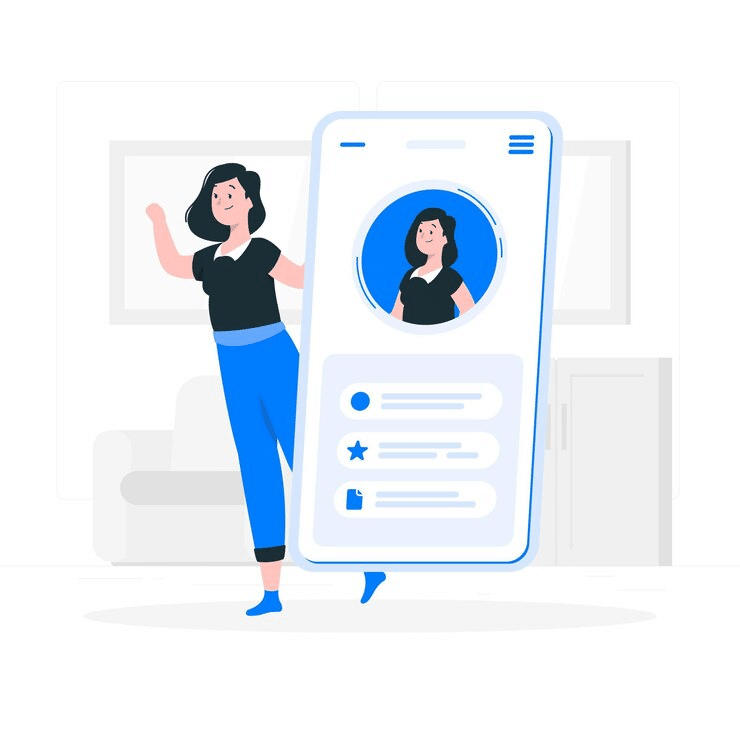
Over 66% of potential customers expect business-to-business (B2B) brands to have a deep understanding of their needs before making a purchase.
Deep personalization helps you show your prospects how well you know them and that you care. This results in more conversions and repeat purchases.
With the right personalization tools, you can deliver customized marketing messages to your prospects and existing customers to make them feel truly valued.
In this article, we will discuss how you can use deep personalization in your marketing efforts to drive big results.
How Does Deep Personalization Work?
Deep personalization is a marketing strategy that uses advanced data and predictive analytics to deliver tailored content, offers, and customer experiences to your prospects.
This process is powered by machine learning and AI tools that analyze customer data, including their website behavior, purchase history, and social media engagement.
The goal is to use these insights to create personalized experiences for each prospect.
For example, take a look at the personalized email Alaska Airlines sent to their prospective customers:

Alaska Airlines personalizes their email by not only using the recipient’s name, but also by incorporating the following data about the recipient: they haven’t opened an email from the company for a while.
The Benefits of Deep Personalization
There are several ways deep personalization can benefit your business:
✅ Improving customer experience
Deep personalization lets you create customized experiences relevant to each consumer.
This could be as simple as personalizing the text in an email. Or it could be as complex as using data sources such as geographic location, buying history, and social media interactions to create customized experiences.
Prospects who have an exceptional experience with your brand are more likely to convert into paying customers and turn into repeat business.
✅ Fostering better relationships
Rather than trying to guess what they might like or selling them something based on demographics—their age, gender, or location—deep personalization works well because it gives customers exactly what they want.
This approach fosters more robust customer relationships by recognizing them as unique individuals, not just entries in a database.
Strengthening these bonds enhances customer loyalty and can lead to referrals.
✅ Increasing conversion rates and sales
A recent Deloitte study found that hyper-personalization can increase marketing return on investment (ROI) by 80%, and boost brand sales significantly.
Deep personalization may improve your sales by quickly guiding customers to what they want, resulting in faster conversions.
✅ Reducing costs
Deep personalization allows customers to reduce overhead costs by minimizing the resources required for customer support.
The more personalized an experience is, the easier it is for customers to find what they need without speaking to a sales representative—more on this later.
The Do’s and Dont’s of Deep Personalization
Here’s our top advice for any businesses wanting to give deep personalization a try:

7 Top Deep Personalization Strategies to Try
Now that you know more about this marketing strategy, you may be wondering how to implement deep personalization. Consider the following tactics:
1. Website personalization
The best way to make a B2B website truly personalized to the visitor is by using data. The better you understand your customers, the more you can tailor your content and messaging to their needs.
This way, each customer sees what they’re interested in—not just what you think they might want based on their demographics.
You can use a website personalization tool like Hyperise to customize your website and landing pages and show dynamic user data when a visitor lands on your site.
The tool personalizes your website for each visitor by matching their firmographic data—information about the business they work for—with the services you offer.
Here’s how you can use Hyperise to do this:

You can also use predictive analytics tools to anticipate future customer behavior based on past interactions. These insights can be used to identify and adapt to patterns for future content.
For example, if you notice that many customers tend to leave after visiting a certain product page or reading just one blog post, you can use data to show them content that resonates with them, keeping them on your site longer.
2. Email personalization
To make emails more personal, companies often use the customer’s name and address in the email subject line. However, this isn’t where the opportunities for personalization end.
To stand out from the other marketing emails in their inbox, you can use actual data from previous conversations with prospects to add more context to your personalized messages.
For example, if someone asked about pricing last month, include a link to pricing information in your next sales proposal.
This will help you tailor each message so that it feels like a conversation between two people instead of an automated email blast.
Here are some more tips for personalizing your emails:
- Use audience segmentation—identifying subgroups within your target audience—to target specific users with content personalized just for them.
- Create a profile based on all the information you have about your users. This includes their behavior, demographics, and interests. Then, use this information to create relevant, personalized content and experiences for them.
- Personalize emails using dynamic content and including consumer data in HTML templates. This guarantees that each recipient receives personalized content tailored to their preferences.
- Use location data to send personalized offers based on where each prospect lives or works. For example, you could say, “It’s going to be a hot one today! You might want to bring your sunglasses to work…”
You can also add personalized images in your emails to score leads. Scoring leads is the process of ranking which prospects should be prioritized based on how ready they are to convert.
For example, if you offer web design services, you might want to encourage your leads to upgrade their site. In this case, you could use Hyperise to include a screenshot of their site in your email campaign to grab their attention:

3. Image personalization
One effective way to build customer relationships is through cold outreach on multiple channels. However, cold outreach isn’t nearly enough with the massive competition you face. But we have a solution!
You can stand out from the crowd by using image personalization in your multi-channel cold outreach campaigns.
For example, Reply.io created two sequences of emails based on templates that were identical, except that one sequence had personalized images while the other did not.
They found that the emails with personalized images generated twice as many warm replies.
Also, when it comes to customer onboarding or welcome emails, personalization makes a good first impression.
Here’s another example of image personalization used for discount emails
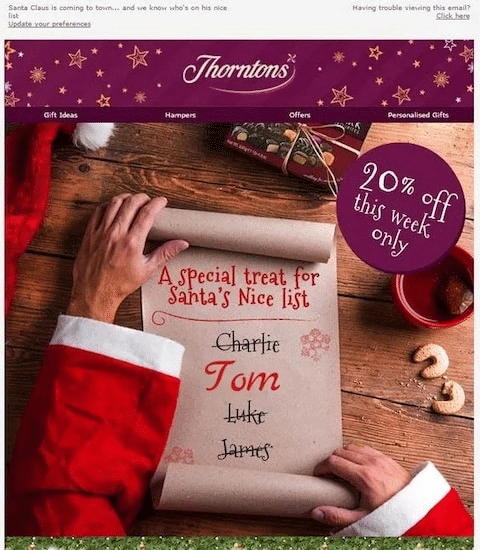
To make image personalization easier, you can turn to tools like Hyperise. Our software helps you create new personalized images using an online editor.
Personalized images are highly effective when integrated into your email or social media lead-generation strategy. Both are channels where audiences expect a personal approach.
You can even add your recipients’ personal details to animated GIFs and use them in your email or LinkedIn outreach:
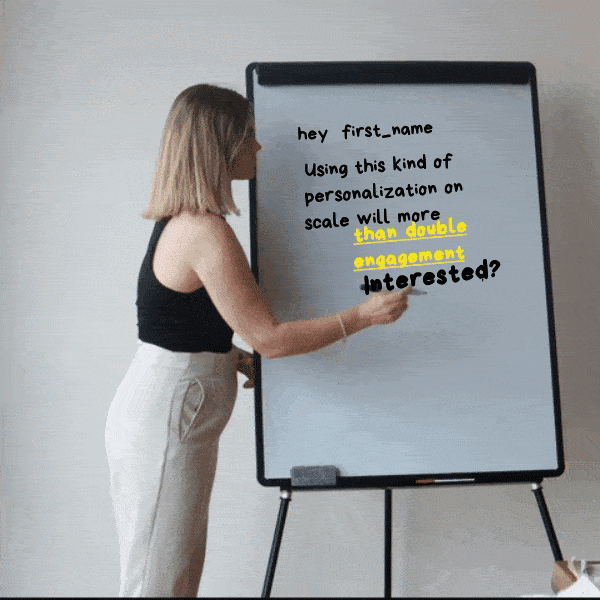
4. Video personalization
Telling stories through video is one of the most effective strategies for building brand awareness and creating a relationship with your audience. This is why 86% of businesses use videos as marketing tools.
However, to make the most of this content, you should personalize your videos. Consumers are more likely to engage with a video that addresses them directly. This means you need to include viewer data.
The good news is that there are many ways to do this. Here are some strategies for creating personalized videos at scale:
- Create unique videos by adding individual viewer data, like a user’s name or company name. This is especially effective for onboarding, training videos, or webinars where viewers learn about a product or service they’ve just purchased.
- Add logos and website screenshots into videos for brand recognition and credibility.
- Use a personal message at the beginning of your video to engage viewers and introduce yourself.
There are tools that let you personalize your videos without any technical knowledge. Take the Hyperise video personalization tool, for example.
Our video marketing tool has a built-in editor to add dynamic text layers to your videos and personalize your voice. It also allows videos to have interactive call-to-action (CTA) buttons and hotspots.
The best part? You don’t have to manually source and input customer data into our tool; we handle it all automatically for you.

5. Personalized product recommendations
Recommendations based on what customers have bought in the past are common in eCommerce marketing. For example, if someone buys one product in a certain category, they may be shown other similar products in marketing messages.
Deep personalization takes this a step further. It involves using data from multiple sources to make predictions about what someone wants to see on your website.
For example, Stitch Fix uses deep personalization to offer a better shopping experience. Based on customer data, the brand sends a selection of clothing or accessories, and shoppers only pay for what they keep and return the rest:

6. Chatbots
Integrating chatbots and other AI-powered virtual assistants into your website helps you respond to visitors in real-time with personalized offers, product recommendations, or answers to their questions.
Additionally, you can use data from their past website interactions to anticipate their future actions.
For example, if they’ve added something to their shopping cart but didn’t complete the purchase, you could use chatbot technology to ask them why they didn’t check out.
You could then offer them a coupon code or other incentive to complete the purchase.
Chatbot technology can also provide discount coupons when asked by the potential customer, like in the example below from HelloFresh:
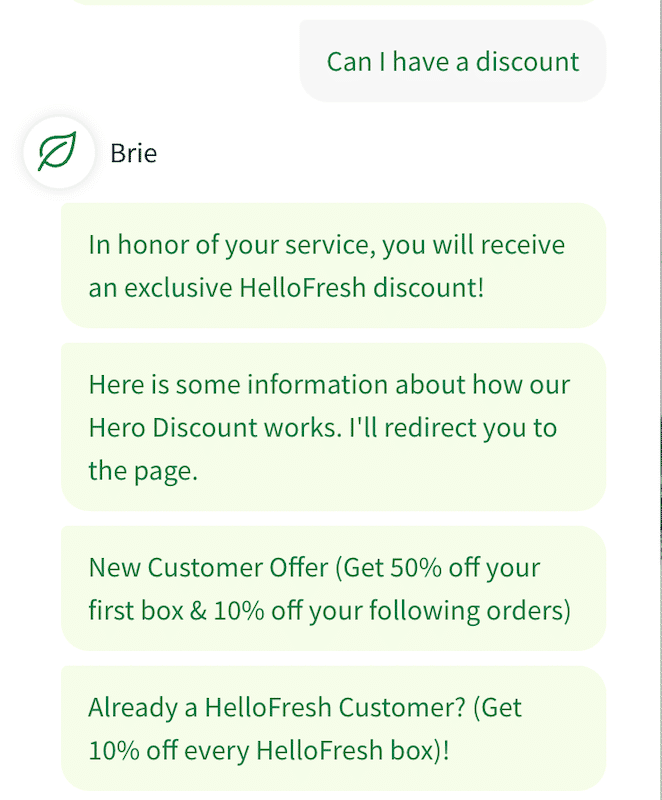
Additionally, smart shoppers often look for external coupon platforms like SaveMyCent to find extra savings before completing their purchase, combining automated incentives with proactive deal hunting can significantly boost conversions.
HubSpot uses a site navigation chatbot that can help users locate pages and content on their sites:
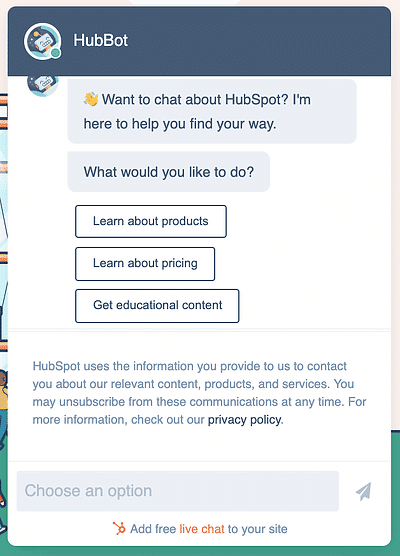
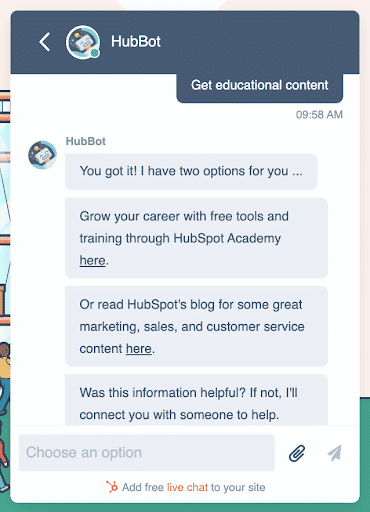
7. Retargeting
Retargeting is a paid advertising strategy where you spend money to have your ads follow people around the web after they’ve visited your site.
It’s a great way to direct people who have already expressed interest in your product or service back to your site.
You can use retargeting campaigns with dynamic ads so that users see different offers based on their behavior—whether they viewed one product or another previously or how long they stayed on each web page.
For example, if someone drops off your site at checkout but has been looking around your website for hours, it could mean they love the product but aren’t ready to make a purchase.
Through personalization, you can show them more information about that specific product on other platforms until they return to your site to make a purchase.
Here’s an example of a retargeting ad personalized for Fortune 500 companies:
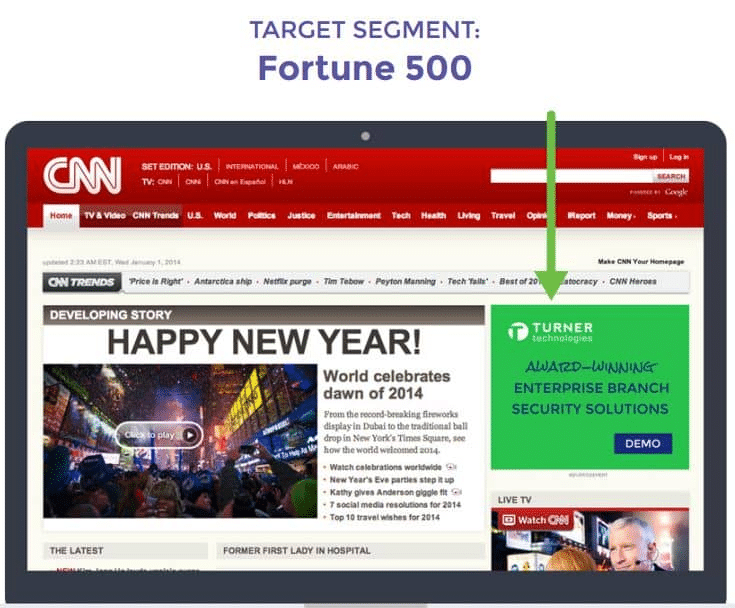
As you can see, the ad campaign is retargeting big enterprises. They use personalized calls-to-action and messaging like “enterprise branch security solutions.”
Here’s another example of a retargeting ad for J. Crew on Facebook:
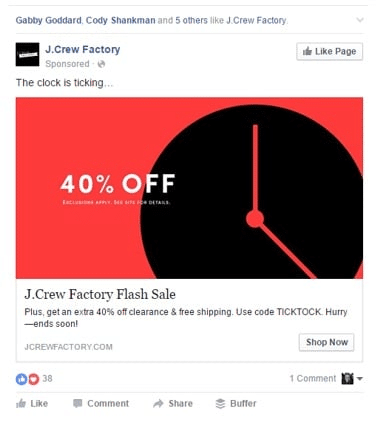
The ad creates a sense of urgency to remind customers, especially those who have previously browsed their products or are familiar with the brand, about the ongoing 40% off sale.
Elevate Your Personalized Marketing with Hyperise
Now that you know just how powerful deep personalization can be, it’s time to start including some of the above tactics in your marketing strategy.
This doesn’t have to be difficult. With a tool like Hyperise, you can personalize images, GIFs, videos, CTAs, maps, QR codes, and text.
Not convinced? Visit our website to try Hyperise out for free for 14 days to see how deep personalization achieves big business results.
Last Updated on May 13, 2024